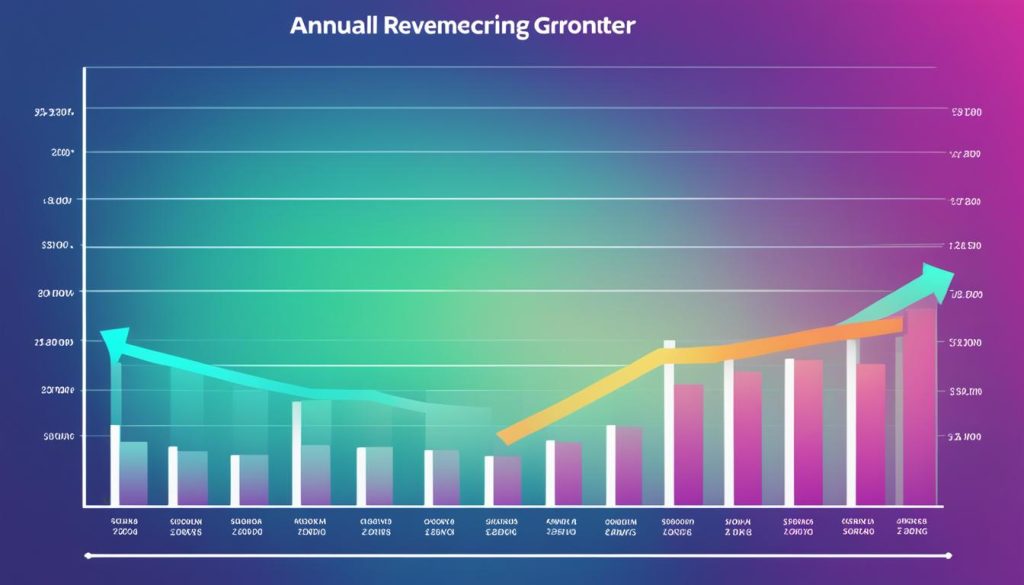Welcome to our comprehensive guide on Annual Recurring Revenue (ARR). In this article, we will provide a clear definition, explanation, and calculation of ARR, as well as explore its importance for SaaS businesses. So, whether you are an entrepreneur looking to understand the recurring revenue model or a business owner seeking to optimize your growth strategies, this guide is for you.
ARR, or Annual Recurring Revenue, is the annual revenue paid by a customer for a product or service in a recurring or subscription manner. It specifically refers to the revenue received on a yearly basis, not including any one-time or lifetime payments. ARR is of great significance to software businesses as it demonstrates a strong core business and the ability to scale up effectively. By providing recurring and predictable income, ARR proves to be a better type of revenue for long-term sustainability and growth.
Now, let’s dive deeper into the world of ARR and discover its implications for SaaS businesses.
What is Annual Recurring Revenue and why is it important for SaaS businesses?
Annual Recurring Revenue (ARR) is a vital metric for SaaS and subscription-based businesses. It provides a clear overview of their performance year on year, allowing companies to forecast growth accurately and track their progress. But why is ARR so crucial for these businesses? Let’s dive into the details.
The Importance of SAAS Revenue Metrics
SAAS businesses operate on a recurring billing model, where customers pay for their services on a subscription basis. This subscription-based revenue is the lifeblood of these businesses, providing a steady and predictable income stream. ARR, as a key metric in SAAS revenue analysis, helps businesses assess the financial health and growth potential of their operations.
Understanding Customer Retention and Churn Rates
ARR plays a crucial role in understanding customer retention and churn rates. By tracking ARR, businesses can identify the percentage of customers who continue to subscribe to their services, as well as the rate at which customers are canceling their subscriptions. This information is invaluable for evaluating the effectiveness of customer acquisition and retention strategies.
Identifying Opportunities for Expansion and Upselling
ARR analysis enables businesses to identify opportunities for expansion and upselling within their existing customer base. By tracking changes in ARR over time, businesses can pinpoint upselling and cross-selling opportunities to increase customer lifetime value. This valuable data helps optimize revenue growth and maximize profitability.
Analyzing the Financial Viability of a Business
ARR is a key factor in analyzing the financial viability of a SaaS business. By determining the revenue generated from recurring subscriptions, businesses can understand their ongoing operational costs, profitability, and potential for scaling up. This analysis helps executives make informed decisions about resource allocation and investment opportunities.
ARR Growth Analysis
The growth in ARR over time is a crucial indicator of a company’s success and market traction. By analyzing ARR growth patterns, businesses can evaluate the effectiveness of their marketing and sales strategies, identify potential market saturation, and assess the need for product diversification or geographic expansion.
In summary, ARR is an essential metric for SaaS businesses as it provides crucial insights into revenue generation, customer retention, expansion opportunities, and the overall financial viability of a company. By leveraging ARR growth analysis, businesses can make data-driven decisions to optimize their strategies, drive sustainable growth, and stay ahead in a highly competitive market.

| Benefits of ARR for SaaS Businesses |
|---|
| Accurate forecasting of growth and profitability |
| Clear understanding of customer retention and churn rates |
| Identification of expansion and upselling opportunities |
| Informed decisions about scaling up and resource allocation |
| Optimization of marketing and sales strategies |
How to Calculate Annual Recurring Revenue?
Calculating Annual Recurring Revenue (ARR) is essential for understanding the financial performance and growth potential of your SaaS or subscription-based business. ARR represents the total revenue you can expect to receive from your customers on an annual basis.
To calculate ARR, follow these steps:
- Start by adding the dollar amount of yearly subscription revenue and recurring expansion revenue. This includes the fees customers pay for the base subscription and any additional recurring charges for upgrades, upsells, and add-ons.
- Next, subtract the revenue lost from churned customers. This accounts for customers who have stopped their subscriptions or no longer generate revenue for your business.
It is important to note that when calculating ARR, you should only include revenue from recurring sources. Exclude one-time charges such as set-up fees, account adjustments, discounts, and other non-recurring charges.
By following these best practices for accurate ARR calculations, you can gain valuable insights into the health and growth of your business.
Example:
| Annual Subscription Revenue | Recurring Expansion Revenue | Lost Revenue from Churned Customers | ARR |
|---|---|---|---|
| $500,000 | $100,000 | $50,000 | $550,000 |
In this example, the business has $500,000 in annual subscription revenue and an additional $100,000 in recurring expansion revenue. However, they have lost $50,000 in revenue from churned customers. Therefore, the ARR for this business is calculated as $550,000.
Calculating ARR helps you monitor your business’s growth and make informed decisions to drive future success. It provides a clear understanding of your recurring revenue, allowing you to plan for expansion, attract investors, and optimize your strategies.

The importance of accurate ARR calculations for SaaS startups
Accurate ARR calculations are essential for SaaS startups to gain a comprehensive understanding of their company’s health and growth. It is crucial to avoid incorrect calculations as they can mislead stakeholders and potential investors, potentially leading to significant issues down the line.
Precise ARR methodology fosters transparency within the organization, enabling startups to present achievable forecasts to investors. By relying on accurate ARR calculations, startups can accurately predict their future revenue and strategically plan their growth initiatives accordingly. This allows them to make informed decisions and ensure that their growth strategies align with their projected financial outcomes.
Image:

| Benefits of accurate ARR calculations for SaaS startups |
|---|
| 1. Enhanced Financial Transparency |
| 2. Attracting Potential Investors |
| 3. Predicting Future Revenue |
| 4. Strategic Growth Planning |
Accurate ARR calculations empower startups to gain a clear understanding of their financial position and make informed decisions regarding their growth trajectory. By following best practices and ensuring precise calculations, startups can effectively leverage ARR to navigate the competitive SaaS landscape and secure long-term success.
Benefits of tracking Annual Recurring Revenue
Tracking annual recurring revenue (ARR) provides several benefits for SaaS businesses. By measuring growth and evaluating the success of business strategies, companies can make informed decisions to drive their success. ARR allows for better planning in areas such as product development, sales, and marketing efforts. It provides a solid foundation for businesses to monitor and analyze revenue trends, enabling them to adjust their strategies accordingly. This type of data-driven decision-making ensures that businesses present accurate reports to stakeholders, fostering transparency and trust.
Benefits of Tracking ARR
1. Measuring Growth: Tracking ARR allows businesses to gauge their revenue growth over time. By analyzing this metric, companies can assess the effectiveness of their sales and marketing efforts, identify areas for improvement, and make data-driven decisions to boost overall growth.
2. Evaluating Business Strategies: ARR analysis helps determine the success and impact of various business strategies. By tracking revenue trends and correlating them with strategic initiatives, businesses can identify which strategies are driving growth and prioritize those for future planning.
3. Effective Planning: ARR acts as a reliable benchmark for planning product development, sales, and marketing efforts. Businesses can align their resources and strategies with revenue projections based on tracked ARR, ensuring efficient allocation of resources.
4. Data-driven Decision-making: Tracking ARR provides businesses with accurate and reliable data that informs decision-making at various levels. Whether it’s choosing the next feature to develop or deciding on expansion plans, data-backed decisions increase the chances of success and minimize risks.
5. Predicting Growth: As ARR is continuously tracked, businesses can forecast future growth trends based on historical data. Predictive analytics can help identify opportunities and challenges, guiding strategies to maximize revenue potential.
6. Raising Capital: When seeking funding or investment, tracking ARR demonstrates a company’s growth potential and financial stability. By presenting a clear and consistent ARR analysis, businesses can attract investors and raise capital for larger growth initiatives.
Example of ARR Tracking
| Year | Total ARR | YoY Growth Rate |
|---|---|---|
| 2018 | £1,000,000 | — |
| 2019 | £1,500,000 | +50% |
| 2020 | £2,500,000 | +66.7% |
As shown in the table above, the company experienced significant annual recurring revenue growth over the three-year period. This growth showcases the effectiveness of their strategies, while also providing a basis for forecasting future revenue projections. By tracking and analyzing ARR, businesses can make informed decisions that drive sustainable growth.

Unit Economics and the viability of a SaaS business
When evaluating the financial viability of a SaaS business, it is essential to consider unit economics, specifically the Lifetime Value (LTV) of a customer and the Cost to Acquire a Customer (CAC). These metrics provide valuable insights into the profitability and sustainability of a SaaS business model.
Lifetime Value (LTV)
The Lifetime Value of a customer measures the total revenue generated by a customer throughout their relationship with the business. It considers both the initial acquisition cost and the recurring revenue generated from that customer over time. A higher LTV indicates a higher profitability of acquiring and retaining customers.
Cost to Acquire a Customer (CAC)
The Cost to Acquire a Customer measures the cost incurred by the business to acquire new customers. It includes marketing expenses, sales commissions, and any other costs directly related to customer acquisition. A lower CAC indicates an efficient and cost-effective customer acquisition strategy.
To ensure the financial viability of a SaaS business, it is crucial to maintain a healthy LTV-to-CAC ratio. A rule of thumb states that this ratio should be higher than 3 to ensure profitability and sustainability. Additionally, businesses should aim to recover the CAC within a reasonable timeframe, ideally within 12 months.
By analyzing these metrics, businesses can assess the health and potential of their SaaS model. Proper monetization of customers through high LTV and efficient customer acquisition strategies are key to long-term success. It allows businesses to optimize their revenue streams and make informed decisions regarding growth and expansion.
LTV-to-CAC Ratio Analysis
| Company Name | Lifetime Value (LTV) | Cost to Acquire a Customer (CAC) | LTV-to-CAC Ratio |
|---|---|---|---|
| Company A | £10,000 | £2,500 | 4 |
| Company B | £5,000 | £2,000 | 2.5 |
| Company C | £20,000 | £7,500 | 2.67 |
Conclusion
Understanding annual recurring revenue (ARR) is crucial for SaaS and subscription-based businesses. ARR provides valuable insights into a company’s performance and growth potential. It allows businesses to make informed decisions and plan for growth by accurately tracking their revenue over time.
Accurate ARR calculations are essential for understanding the financial viability of a business. By following best practices and including only relevant recurring revenue in the calculations, businesses can avoid misleading stakeholders and potential investors. Precise ARR methodology ensures transparency and enables startups to present achievable forecasts.
Tracking ARR not only helps in evaluating the success of business strategies but also enables better planning for product development, sales, and marketing efforts. It allows businesses to make data-driven decisions and present accurate reports to stakeholders. Additionally, by predicting growth and raising capital through accurate ARR tracking, businesses can embark on larger growth initiatives with confidence.
In conclusion, ARR is a vital metric for SaaS and subscription-based businesses. By understanding and accurately calculating ARR, businesses can optimize their strategies, attract investors, and plan for long-term success.





